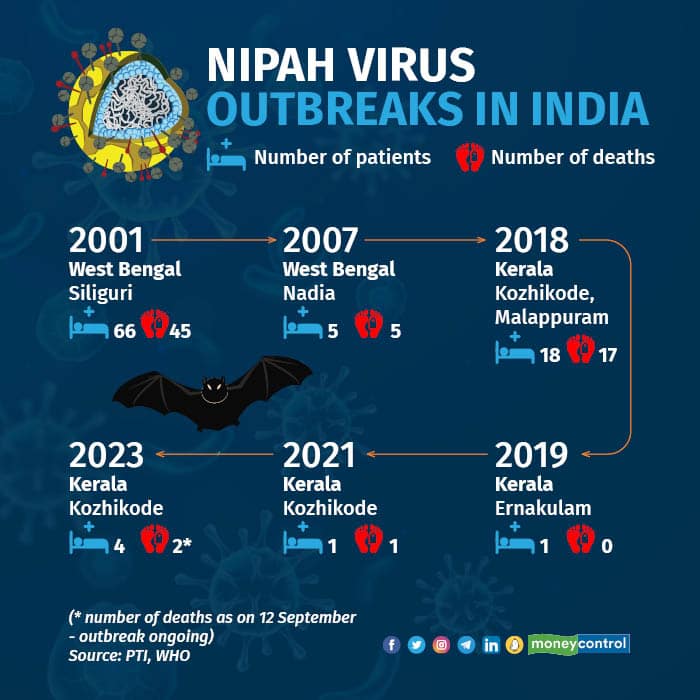



Kerala has said that tests from the ICMR-National Institute of Virology (NIV), Pune has confirmed that four individuals have tested positive for Nipah on 12 September late evening. Union Minister of Health Mansukh Mandaviya had earlier disclosed that two fatalities in Kozhikode, Kerala, were due to the Nipah virus on September 12. He said that a central team of experts has been sent to Kerala to take stock of the situation and assist the state government in the management of the Nipah virus infection.
This is the fifth time the disease has been detected in India. According to the National Centre for Disease Control, Nipah is a zoonotic virus, meaning that it initially spreads between animals and people.
The primary animal host reservoir for Nipah is a fruit bat, colloquially known as the flying fox. Infected fruit bats serve as vectors for transmitting the virus to humans and other animals, such as pigs. Human infection may occur through close contact with infected animals or their bodily fluids, including saliva and urine, a phenomenon referred to as a "spillover event".

1) The first outbreak in India was reported between January and February 2001 in the Siliguri district of West Bengal. Due to its proximity to Bangladesh and initial challenges in identifying the causative agent, retrospective testing of patient samples confirmed the presence of the virus. This severe outbreak resulted in 45 fatalities among 66 confirmed cases, with a mortality rate of 68 percent. Notably, the index patient's identity remains elusive, and the outbreak was primarily nosocomial (spread through hospital) in nature, with no evidence implicating animals.
2) The second Nipah outbreak was reported in Nadia district of West Bengal in 2007. All five Nipah-positive patients died within 10 days of infection leading to a fatality rate of 100 percent in this outbreak.
3) On May 19, 2018, a Nipah virus outbreak was reported from the Kozhikode district of Kerala. This was the first Nipah outbreak in South India. The outbreak happened in the two north Kerala districts of Kozhikode and Malappuram. Out of the 18 cases, 17 people died in this outbreak, which was declared contained after May 30, 2018.
4) A 23-year-old student was detected with the virus again on June 4, 2019, in Kochi. In this incident, over 300 people were put under observation, but no further cases were reported. The student later recovered.
5) In 2021, the Nipah virus outbreak started with the death of a 12-year-old boy in Pazhur, Kozhikode. The outbreak, which claimed one life, was contained and declared over on September 5, 2021.
6) The Union Health Ministry has confirmed that the two people who recently died in Kerala's Kozhikode due to “unnatural fever” were infected by the Nipah virus. The state health department, having suspected Nipah infection, had sent the samples to the ICMR-National Institute of Virology, Pune, which reportedly confirmed the presence of the virus on the evening of September 12. Later in the evening, the state received reports from NIV that four individuals tested positive for the virus. Two individuals are under treatment in Kozhikode while the others are deceased.
The current situationAddressing a press meet on the 12th morning, Kerala Health Minister Veena George said that four family members of the 49-year-old deceased man have been admitted to the hospital with fever and are under treatment. She added that both the deceased had come in contact with each other at the hospital. The Kozhikode Medical College hospital is increasing preparedness for an outbreak with 75 isolation beds. The medical college is also ready with ventilator support, according to the state health minister.
The state government has prepared a contact list of the 2 patients. About 168 individuals who have come in contact with either of them have been identified by the Kerala State Health Department. The state has formed 16 core committees to tackle the disease outbreak.
Kerala Health Minister Veena George said in a press conference that three expert committees will arrive in Kozhikode by tomorrow. The first is a team from NIV Pune, which will arrive as a mobile team to Kozhikode to facilitate detection, testing of the virus. An ICMR-NIV team is arriving in Kerala to conduct a bat field survey in the area. Another team from ICMR National Institute of Epidemiology, Chennai, will arrive in Kerala soon for epidemiological testing related to the virus.
Virulence and detectionAccording to the World Health Organization (WHO) and the US CDC (Centre for Disease Control), the symptoms of Nipah infection range from mild to severe, with death occurring in 40 percent-70 percent of those infected in documented outbreaks between 1998 and 2018.
Nipah virus infection can be diagnosed during the infection period; the virus RNA can be detected using reverse transcriptase polymerase chain reaction (RT-PCR) from throat swabs, cerebrospinal fluid, urine and blood analysis.
The WHO states that the disease manifests in infected individuals as a spectrum of illnesses, from asymptomatic infection to acute respiratory illness and fatal encephalitis. Initial symptoms include fever, headaches, myalgia, vomiting, and sore throat, followed by dizziness, drowsiness, altered consciousness, and neurological signs indicative of acute encephalitis.
The incubation period (the time from infection to symptom onset) is believed to range from 4 to 14 days, as per the WHO.
Discover the latest Business News, Sensex, and Nifty updates. Obtain Personal Finance insights, tax queries, and expert opinions on Moneycontrol or download the Moneycontrol App to stay updated!
Find the best of Al News in one place, specially curated for you every weekend.
Stay on top of the latest tech trends and biggest startup news.